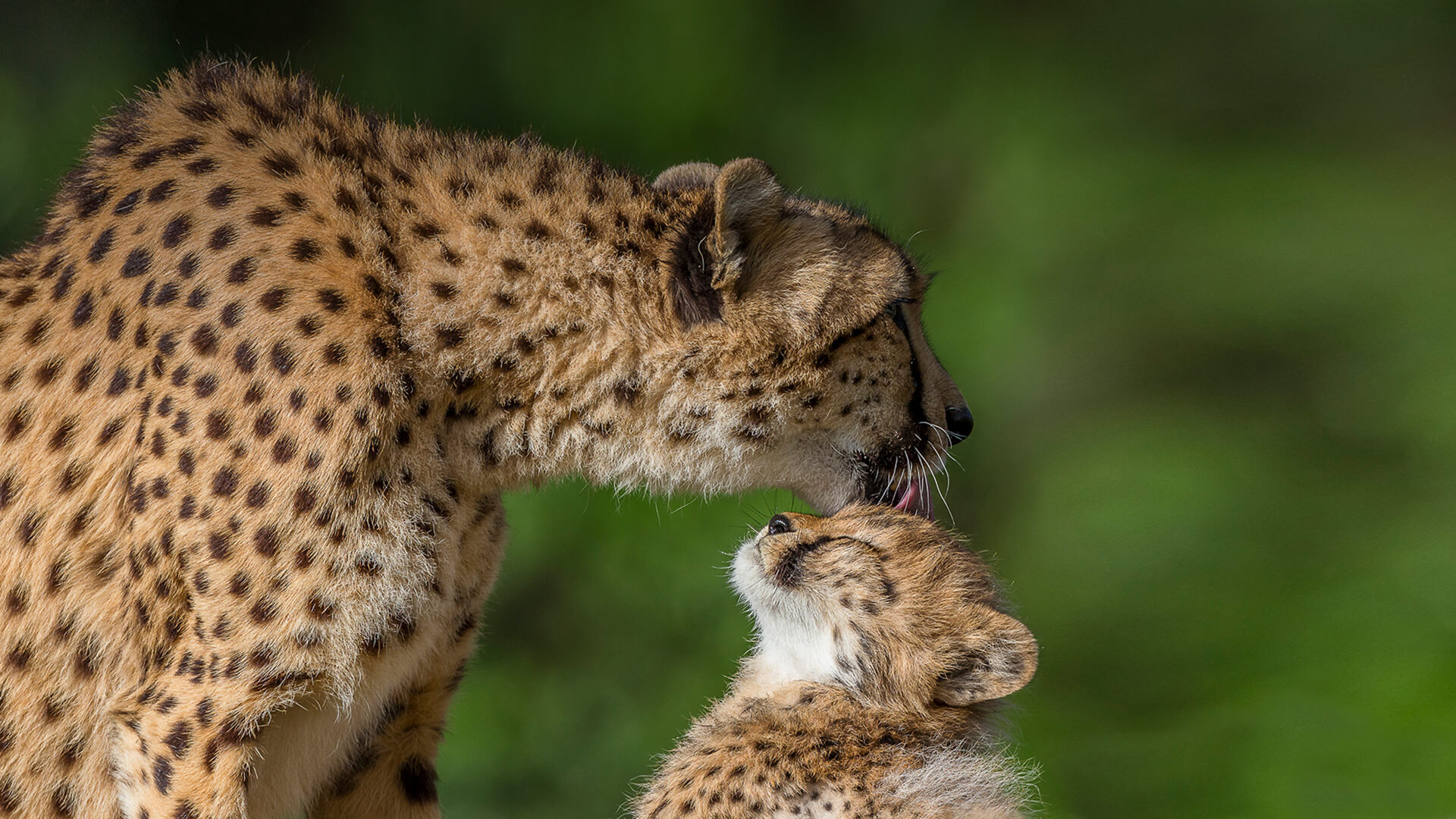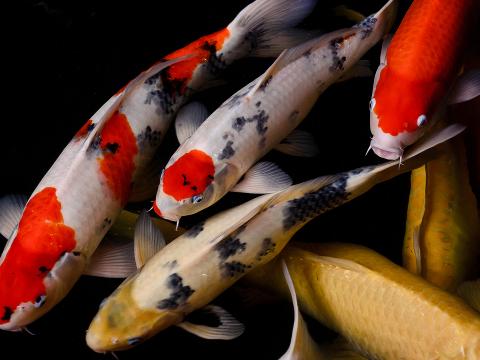Cheetah
- Class: Mammalia (Mammals)
- Order: Carnivora
- Family: Felidae
- Genus: Acinonyx
- Species: jubatus
ABOUT
Spotted sprinter. If ever an animal was born to run, it’s the cheetah. People have marveled at this fastest of land mammals for thousands of years. Egyptian tombs and rock temples show representations of the cheetah, and many ancient cultures used the cheetah for its hunting prowess, much the way falcons are used in many countries to accompany hunters. The cheetah has adorned the courts of kings, queens, and emperors, and its amazing grace and beauty still amaze the world today.
Social life on the savanna. Cheetahs are found primarily in the eastern and southern ranges of Africa south of the Sahara Desert, with small populations in North Africa and Iran. They are neither solitary nor social but are a little of both. Females are solitary except when they have young. Some males are solitary, but related males, usually brothers, live in small groups called coalitions. Adult males are larger than females and have a “mane” on the shoulder area that can also be seen on cubs. Cheetahs are peaceable except at breeding time, when males fight over females and have been known to kill each other. Cheetahs hunt alone and don’t have any of the group behaviors that lions do.
Run like the wind. Long and lanky, cheetahs are the sprinters of the cat world. Their bodies are uniquely designed to run very fast for fairly short distances, allowing them to catch prey that other big cats can’t get. A cheetah’s ability to run starts with its flexible spine, which allows the front legs to stretch far forward on each stride. Its claws are hard and sharp like cleats, giving the cat great traction when running. A cheetah can retract its claws a bit, but the fleshy sheaths that protect the claws of most cats are absent in the cheetah. Most of the claws are exposed all the time, so they don't stay sharp like those of other cats.
A small, cone-shaped piece of bare skin on the back of each front leg serves as a brake. The cat’s long tail is used as a rudder during high-speed chases, and its enlarged nostrils, lungs, and heart are adaptations that help a cheetah exert itself.
While running, a cheetah covers 20 to 22 feet (6 to 6.7 meters) in one stride, about the same distance as a racehorse. But a cheetah is so much faster—the fastest racehorse runs 43 miles per hour (69 kilometers per hour), while a cheetah can run at speeds of up to 70 miles per hour (112 kilometers per hour). A cheetah is off the ground more than half of its running time!
Running down a meal. Chasing prey is hard on a cheetah. Once caught, a cheetah holds its prey with a strangling bite to the neck. The cheetah pants intensely, and its body temperature can reach as high as 105 degrees Fahrenheit (41 degrees Celsius). It takes 20 minutes for its breathing and temperature to return to normal, the same time it takes for the prey to suffocate. A cheetah has smaller teeth and larger nasal passages than other big cats, which may be an adaptation that allows the cat to take in more air during the recovery period after a sprint.
HABITAT AND DIET
Home on the range. The cheetah survives in parts of Africa and a small population lives in Iran. They prefer grasslands and open plains. Here, they are well camouflaged and have room to run down their prey.
Fast food. Once they’ve recovered from chasing down a meal, cheetahs must eat quickly, as leopards, lions, baboons, jackals, vultures, or hyenas can drive them away. Cheetahs aren’t strong enough to hide or guard their catch, so they have only one chance to eat their meal. They must kill more often, expending more energy than other big cats. They eat the meat (not usually the skin or bones) of antelope (usually Thompson’s gazelles), ground-dwelling birds, rabbits, porcupines, and ostriches. Unlike other African predators, cheetahs don’t usually scavenge for food. They tend to hunt in the morning and again at dusk. They can hunt during the middle of the day if they have to, but during the heat of the day they prefer to rest.
Cheetahs hunt by sight. But before the cat attacks or even begins to stalk its prey, the cheetah watches a herd from a high vantage point like a termite mound or a tree. It picks out its prey—perhaps an individual that is young or very old and that isn’t quite keeping up with the rest of its herd, or one that wanders away from the herd—and creeps as close as it can without being noticed. It stalks its prey in a semi-crouched position with its head lowered and freezes or drops to the ground to avoid being discovered. A cheetah tries to get within about 165 feet (50 meters) before it charges. You might think that a cheetah’s prey doesn’t stand a chance, but cheetahs don’t always catch the prey they’re chasing. In fact, cheetahs catch their prey in only half of the hunting attempts they make.
At the San Diego Zoo and San Diego Zoo Safari Park, the cheetahs eat a special ground-meat diet made for carnivores.
FAMILY LIFE
Hear that? San Diego Zoo Wildlife Alliance scientists began studying communication in African cheetahs and soon learned that cheetahs were much more vocal (and possessed a larger vocabulary) than originally thought. A chirp call, which sounds a little like a small dog’s bark, is uttered often by both males and females and has a variety of meanings, ranging from “good morning” to “I’m not happy with you,” and even “What just happened was kind of scary!” Mothers use the same sound to call their cubs. They also purr, growl, snarl, hiss, cough, moan, and bleat, but cheetahs cannot roar like lions or tigers do.
Scientists have learned that, during mating season, cheetah males make a unique sound called a “stutter-bark,” which is a very rhythmic and repetitive call that sounds like a cross between a purr and a rumbling stomach. The stutter-bark seems to play a role in getting an available female “in the mood” for breeding. Scientists can play a recording of this call to female cheetahs at the San Diego Zoo Safari Park to encourage breeding. Two cubs born in 2009 were the result of this method.
Tiny spots. Female cheetahs usually give birth to three to five cubs, but some females have had up to eight cubs in one litter. Cubs are born with all their spots, so they appear much darker than the adults. They also have a stripe of long, silver fur called a mantle that runs down their back. This extra fur may help to protect the cub from weather or camouflage it in the tall grass.
At about six months of age, the mother teaches her cubs how to hunt and avoid predators. Cubs live with their mothers for about 18 months but often become prey to lions, leopards, and hyenas. Scientists found that lions and hyenas kill up to 70 percent of cheetah cubs. To protect her cubs, a mother moves them frequently. Littermates stay together for about six to eight more months, sharing a territory. Then the females head off to live on their own, while the males stay together in small groups until they are mature.
CONSERVATION
Once widespread throughout Africa and the Arabian Peninsula and into central India, cheetahs have disappeared from huge areas of their historic range. Cheetahs hunt by day, which means tourists taking safari rides into cheetah habitat can affect their daily routine. Their habitat is open savanna, the most likely areas to be occupied by humans. There are around 7,000 cheetahs left in their native habitats, down from as many as 100,000 just 100 years ago. Ranchers sometimes shoot them because the cats feed on livestock.
Wildlife parks in Africa help protect some of the cheetahs as their habitat shrinks. Zoos will play an important role in securing a future for cheetahs. The San Diego Zoo Safari Park has been working to solve the unique problems that cheetahs have breeding in managed care. It has one of the most successful cheetah breeding programs in the world, with 157 cheetahs born here to date, and is considered a top organization for successful cheetah management.
Help for cheetahs. In Namibia, prickly thornbush has been taking over farms and grasslands, injuring the cats’ eyes and causing them to prey on easier-to-catch livestock, much to the farmers’ dismay. The Cheetah Conservation Fund (CCF) sent wood chippers to chop up the brush to make it easier for cheetahs to hunt. The chipped thornbush is turned into blocks and sold as fuel. The Fund also introduced a very successful guard dog program in Namibia, using Anatolian shepherds to protect livestock. These working dogs are fiercely protective of the livestock in their charge, and the cheetahs are not about to argue. Providing the dogs free of charge to households and educating people about the value of native wildlife has helped cheetah populations recover in Namibia. Laurie Marker, Ph.D., who founded CCF in 1990, received San Diego Zoo Wildlife Alliance's prestigious conservation medal in 2008 for her work for these cats.
San Diego Zoo Wildlife Alliance is a member of the national cheetah Breeding Center Coalition (BCC). The Coalition’s nine member facilities are breeding cheetahs with the goal of creating a sustainable cheetah population. As a leading partner, we are working closely with the other BCC members to ensure that cheetah numbers increase significantly over the next decade, ultimately resulting in a sustainable “safety net” population.
You can join conservation organizations that protect big cats and African habitat, including the Cheetah Conservation Fund and Africats. You can encourage people not to wear fur coats. While it can be hard to help cheetahs directly, when you make your voice heard on environmental issues, you can help the Earth as a whole.
Visiting the San Diego Zoo and the San Diego Zoo Safari Park helps support our work to learn more about a disease affecting cheetahs. Feline herpesvirus can cause respiratory disease and skin ulcers in cheetahs. To prevent this, our conservation scientists are studying the risk factors that cause this infection in cheetahs and creating a database of infected individuals, including management and wildlife care practices from zoos across North America. We can then recommend changes in the care of cheetahs to reduce the virus risk for these cats.
By supporting San Diego Zoo Wildlife Alliance, you are our ally in saving and protecting wildlife worldwide.










